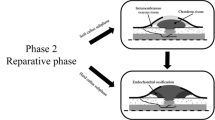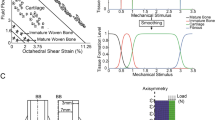Abstract
The combined use of experimental and mathematical models can lead to a better understanding of fracture healing. In this study, a mathematical model, which was originally established by Bailón-Plaza and van der Meulen (J Theor Biol 212:191–209, 2001), was applied to an experimental model of a semi-stabilized murine tibial fracture. The mathematical model was implemented in a custom finite volumes code, specialized in dealing with the model’s requirements of mass conservation and non-negativity of the variables. A qualitative agreement between the experimentally measured and numerically simulated evolution in the cartilage and bone content was observed. Additionally, an extensive parametric study was conducted to assess the influence of the model parameters on the simulation outcome. Finally, a case of pathological fracture healing and its treatment by administration of growth factors was modeled to demonstrate the potential therapeutic value of this mathematical model.








Similar content being viewed by others
References
Adam JA (1999) A simplified model of wound healing (with particular reference to the critical size defect). Math Comput Model 30:23–32
Anderson ARA, Chaplain MAJ (1998) Continuous and discrete mathematical models of tumor-induced angiogenesis. B Math Biol 60:857–900
Arnold JS, Adam JA (1999) A simplified model of wound healing II: The critical size defect in two dimensions. Math Comput Model 30:47–60
Bailón-Plaza A, van der Meulen MCH (2001) A mathematical framework to study the effects of growth factor influences on fracture healing. J Theor Biol 212:191–209
Bailón-Plaza A, van der Meulen MCH (2003) Beneficial effects of moderate, early loading and adverse effects of delayed or excessive loading on bone healing. J Biomech 36:1069–1077
Barnes GL, Kostenuik PJ, Gerstenfeld LC, Einhorn TA (1999) Growth factor regulation of fracture repair. J Bone Miner Res 14(11):1805–1815
Carter DR, Beaupré GS, Giori NJ, Helms JA (1998) Mechanobiology of skeletal regeneration. Clin Orthop Relat R 355S:S41–S55
Cho T-J, Gerstenfeld LC, Einhorn TA (2002) Differential temporal expression of members of the transforming growth factor β superfamily during murine fracture healing. J Bone Miner Res 17(3):513–520
Coffey RJ, Russell WE, Barnard JA (1990) Pharmacokinetics of TGF beta with emphasis on effects in liver and gut. Ann NY Acad Sci 593:285–291
Colnot C, Thompson Z, Miclau T, Werb Z, Helms JA (2003) Altered fracture repair in the absence of MMP9. Development 130:4123–4133
Cruess RL, Dumont JR (1985) Healing of Bone. In: Newton CD, Nunamaker DM (eds) Textbook of small animal orthopaedics. International Veterinary Information Service, Ithaca, New York, USA
Dallon JC, Sherratt JA, Maini PK (1999) Mathematical modelling of extracellular matrix dynamics using discrete cells: fiber orientation and tissue regeneration. J Theor Biol 199:449–471
Dasch JR, Pace DR, Waegell W, Inenaga D, Ellingsworth L (1989) Monoclonal antibodies recognizing transforming growth factor-beta. Bioactivity neutralization and transforming growth factor beta 2 affinity purification. J Immunol 142:1536–1541
Dimitriou R, Tsiridis E, Giannoudis PV (2005) Current concepts of molecular aspects of bone healing. Injury 36 (available online)
Edelman ER, Nugent MA, Karnovsky MJ (1993) Perivascular and intravenous administration of basic fibroblast growth factor: vascular and solid organ deposition. Proc Natl Acad Sci USA 90:1513–1517
Einhorn TA (1998) The cell and molecular biology of fracture healing. Clin Orthop Relat R 355S:S7–S21
Fedarko NS, D'Avis P, Frazier CR, Burrill MJ, Fergusson V, Tayback M, Sponseller PD, Shapiro JR (1995) Cell proliferation of human fibroblasts and osteoblasts in osteogenesis imperfecta: influence of age. J Bone Miner Res 10:1705–1712
Gaffney EA, Maini PK, Sherratt JA, Ruft S (1999) The mathematical modelling of cell kinetics in corneal epithelial wound healing. J Theor Biol 197:15–40
Gerisch A (2001) Numerical methods for the simulation of taxis-diffusion-reaction systems. PhD Thesis, Martin-Luther-Universität Halle-Wittenberg
Gerisch A, Chaplain MAJ (2006) Robust numerical methods for taxis-diffusion-reaction systems: applications to biomedical problems. Math Comput Model 43:49–75
Gerstenfeld LC, Cullinane DM, Barnes GL, Graves DT, Einhorn TA (2003) Fracture healing as a post-natal developmental process: molecular, spatial, and temporal aspects of its regulation. J Cell Biochem 88:873–884
Gerstenfeld LC, Cho T-J, Kon T, Aizawa T, Tsay A, Fitch J, Barnes GL, Graves DT, Einhorn TA (2003b) Impaired fracture healing in the absence of TNF-α signaling: the role of TNF-α in endochondral cartilage resorption. J Bone Miner Res 18(9):1584–1592
Gruler H, Bültmann BD (1984) Analysis of cell movement. Blood Cells 10:61–77
Hadjiargyrou M, Lombardo F, Zhao S, Ahrens W, Joo J, Ahn H, Jurman M, White DW, Rubin CT (2002) Transcriptional profiling of bone regeneration. J Biol Chem 277(33):30177–30182
Hundsdorfer W, Verwer JG (2003) Numerical solution of time-dependent advection–diffusion-reaction equations. Springer Series in Computational Mathematics 33, Springer, Berlin Heidelberg New York
Joyce ME, Roberts AB, Sporn MB, Bolander ME (1990) Transforming growth factor-β and the initiation of chondrogenesis and osteogenesis in the rat femur. J Cell Biol 110:2195–2207
Levine HA, Pamuk S, Sleeman BD, Nilsen-Hamilton M (2001) Mathematical modelling of capillary formation and development in tumor angiogenesis: penetration into the stroma. B Math Biol 63:801–863
McDougall SR, Anderson ARA, Chaplain MAJ, Sherratt JA (2002) Mathematical modelling of flow through vascular networks: implications for tumour-induced angiogenesis and chemotherapy strategies. B Math Biol 64:673–702
Olsen L, Sherratt JA, Maini PK, Arnold F (1997) A mathematical model for the capillary endothelial cell-extracellular matrix interactions in woundhealing angiogenesis. IMA J Math Appl Med Biol 14:261–281
Pettet GJ, Byrne HM, McElwain DLS, Norburry J (1996) A model of wound-healing angiogenesis in soft tissue. Math Biosci 136:35–63
Plank MJ, Sleeman BD, Jones PF (2004) A mathematical model of tumour angiogenesis, regulated by vascular endothelial growth factor and the angiopoietins. J Theor Biol 229:435–454
Seeherman H, Li R, Wozney J (2003) A review of preclinical program development for evaluating injectable carriers for osteogenic factors. J Bone Joint Surg Am 85:96–108
Sherratt JA, Murray JD (1990) Models of epidermal wound healing. Proc R Soc Lond B Biol 241:29–36
Southwood LL, Frisbie DD, Kawcak CE, McIlwraith CW (2004) Delivery of growth factors using gene therapy to enhance bone healing. Vet Surg 33:565–578
Street J, Bao M, deGuzman L, Bunting S, Peale FV Jr., Ferrara N, Steinmetz H, Hoeffel J, Cleland JL, Daugherty A, van Bruggen N, Redmond HP, Carano RAD, Filvaroff EH (2002) Vascular endothelial growth factor stimulates bone repair by promoting angiogenesis and bone turnover. Proc Natl Acad Sci USA 99(15):9656–9661
Tranquillo RT, Murray JD (1992) Continuum model of fibroblast-driven wound contraction-inflammation mediation. J Theor Biol 158:135–172
Turner ND, Knapp JR, Byers FM, Kopchick JJ (2001) Physical and mechanical characteristics of tibias from transgenic mice expressing mutant bovine growth hormone genes. Exp Biol Med 226:133–139
Vander A, Sherman J, Luciano D (1998) Human physiology: the mechanisms of body function. WCB McGraw-Hill, Boston
Weiner R, Schmitt BA, Podhaisky H (1997) ROWMAP—a ROW-code with Krylov techniques for large stiff ODEs. Appl Numer Math 25:303–319
Acknowledgements
Liesbet Geris is a research assistant of the Research Foundation Flanders (FWO-Vlaanderen). Hans Van Oosterwyck and Christa Maes are postdoctoral fellows of the Research Foundation Flanders (FWO-Vlaanderen). The authors wish to thank Dr. Alicia Bailón-Plaza for her scientific advice.
Author information
Authors and Affiliations
Corresponding author
Appendix A
Appendix A
This appendix contains the non-dimensionalized equations and parameters of the mathematical model, the temporal and spatial parameters of the model, the scaling values for the seven dependent variables and the values of boundary and initial conditions. The seven dependent variables are the concentration of mesenchymal stem cells (c m ), chondrocytes (c c ) and osteoblasts (c b ), the density of the fibrous/cartilaginous (m c ) and bone (m b ) ECM (total matrix density m=m c +m b ) and the concentration of a chondrogenic (g c ) and an osteogenic (g b ) growth factor. The meaning of the model parameters is explained in Bailón-Plaza and van der Meulen [4]. Most of the parameter values were derived from experimental results reported in literature but a few of them were estimated. Some of these estimated parameter values were altered (boldface) in this study, in order to obtain a better correspondence between simulation results and experimental data.
-
Non-dimensionalized equations and parameters
$$\frac{\partial c_m}{\partial t} = \nabla \left[D_{cm} \nabla c_m - Cc_m \nabla m \right] + A_{m} c_{m} \left[1 - \alpha_{m} c_{m} \right] - F_{1} c_{m} - F_{2} c_{m} $$(2)$$\frac{\partial c_c}{\partial t} = A_c c_c \left[1 - \alpha_c c_c\right] + F_2 c_m - F_3 c_c$$(3)$$\frac{\partial c_b}{\partial t} = A_b c_b \left[1 - \alpha_b c_b\right] + F_1 c_m + F_3 c_c - d_b c_b$$(4)$$\frac{\partial m_c}{\partial t} = P_{cs} \left(1 - \kappa_c m_c\right)\times\left(c_m + c_c \right) - Q_{cd2} m_c c_b$$(5)$$\frac{\partial m_b}{\partial t} = P_{bs} \left(1 - \kappa_b m_b\right)c_b $$(6)$$\frac{\partial g_c}{\partial t} = \nabla \left[D_{gc} \nabla g_c \right] + E_{gc} c_c - d_{gc} g_c $$(7)$$\frac{\partial g_b}{\partial t} = \nabla \left[D_{gb} \nabla g_b \right] + E_{gb} c_b - d_{gb} g_b $$(8)$$\begin{aligned} D_{cm} &= \frac{D_h}{\left(K_h^2 + m^2\right)}m \quad F_1 = \frac{Y_1}{\left(H_1 + g_b\right)} g_b \\ C &= \frac{C_k}{\left(K_k + m\right)^2} \quad F_2 = \frac{Y_2}{\left(H_2 + g_c\right)} g_c \\ A_m &= \frac{A_{mo}}{\left(K_m^2 + m^2\right)}m \quad F_3 = \frac{m_c^6}{\left(B_{ec}^6 + m_c^6\right)} \times \frac{Y_3}{\left(H_3 + g_b\right)} g_b \\ A_c &= \frac{A_{co}}{\left(K_c^2 + m^2\right)}m \quad E_{gc} = \frac{G_{gc} g_c}{\left(H_{gc} + g_{c}\right)} \times \frac{m}{\left(K_{gc}^3 + m^3\right)} \\ A_b &= \frac{A_{bo}}{\left(K_b^2 + m^2\right)}m \quad E_{gb} = \frac{G_{gb}g_b}{\left(H_{gb} + g_b\right)}\\ \end{aligned}$$D h =0.014 [23], K h =0.25 [23], C k =0.0034 [23], K k =0.5 [23], A mo =1.01, K m =0.1, α m =1, A co =0.101, K c =0.1, α c =1, A bo =0.202 [17], K b =0.1, α b =1, Y 1=10, H 1=0.1, Y 2=50, H 2=0.1, Y 3 =500, B ec =1.5, H 3=0.1, d b =0.1, P cs =0.2 [29], κ c =1 [29], Q cd2 =1.5, P bs =2, κ b =1, D gc =0.005 [26, 38], D gb =0.005 [26, 38], G gc =50, H gc =1, K gc =0.1, G gb =350, H gb =1, d gc =100 [9, 13, 15], d gb =100 [9, 13, 15].
-
Scaling parameters: T=1 day, L=3.5 mm, c 0=106 cells ml−1, m 0=0.1 g ml−1 [29], g 0=100 ng ml−1 [26].
-
Initial and boundary conditions: \(m_{c\_ini} = 0.1,\) \({\bf c}_{\bf m\_bc} = {\bf 0.02}\) (during the first 3 days), \(g_{c\_bc} = g_{b\_bc} = 2\) (during 20 days).
Rights and permissions
About this article
Cite this article
Geris, L., Gerisch, A., Maes, C. et al. Mathematical modeling of fracture healing in mice: comparison between experimental data and numerical simulation results. Med Bio Eng Comput 44, 280–289 (2006). https://doi.org/10.1007/s11517-006-0040-6
Received:
Accepted:
Published:
Issue Date:
DOI: https://doi.org/10.1007/s11517-006-0040-6




